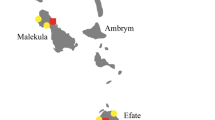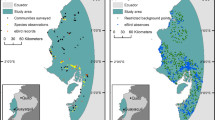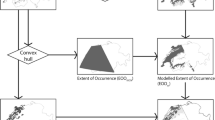Abstract
Endemic species play an important role in conservation ecology. However, knowledge of the real distribution and ecology is still scarce for many endemics. The aims of this study were to predict the distribution of the short-range endemic Alpine jumping bristletail Machilis pallida; to evaluate the actual level of endemism via ground validation using an iterative approach for testing the models in field trips and increasing the quality of the prediction step by step; and to test the potential of species distribution modelling for increasing the knowledge about the ecological niche. Based on seven known locations of M. pallida, we used species distribution modelling via Maxent. After a set of seven field trips a new model was built if new locations were found. Three such iterations were performed to increase model quality. We discovered four new locations of M. pallida, increasing the area of known distribution from 470 to 4,890 km2. The distribution of M. pallida is thus wider than formerly known, but our results support Eastern Alpine endemism of the species. The knowledge about the ecological niche could be increased due to the newly found locations. Our study showcases the potential of the iterative approach of modelling and ground validation to evaluate the actual level of endemism and the ecological niche in Alpine species and beyond.




Similar content being viewed by others
References
Anderson RP, Lew D, Peterson AT (2003) Evaluating predictive models of species’ distributions: criteria for selecting optimal models. Ecol Model 162:211–232
Araújo MB, Pearson RG (2005) Equilibrium of species’ distributions with climate. Ecography 28:693–695
Beaumont LJ, Hughes L, Poulsen M (2005) Predicting species distributions: use of climatic parameters in BIOCLIM and its impact on predictions of species’ current and future distributions. Ecol Model 186:251–270
Boyce MS, Vernier PR, Nielsen SE, Schmiegelow FKA (2002) Evaluating resource selection functions. Ecol Model 157:281–300
Buschinger A (2009) Social parasitism among ants: a review (Hymenoptera: Formicidae). Myrmecol News 12:219–235
Cassagne N, Gauquelin T, Bal-Serin M, Gers C (2006) Endemic Collembola, privileged bioindicators of forest management. Pedobiol 50:127–134
Christian E, Knoflach B (2009) Jumping bristletails (Archaeognatha) in Austria: current knowledge and gaps. In: Tajovský K, Schlaghamerský J, Pižl V (eds) Contributions to soil zoology in Central Europe III. ISB BC AS CR, České Budějovice, pp 9–12
Colwell R, Brehm G, Cardelús C, Gilman A, Longino JT (2008) Global warming, elevational range shifts, and lowland biotic attrition in the wet tropics. Science 322:258–261
Costa GC, Nogueira C, Machado RB, Colli GR (2010) Sampling bias and the use of ecological niche modeling in conservation planning: a field evaluation in a biodiversity hotspot. Biodivers Conserv 19:883–899
Cowling RM (2001) Endemism. In: Simon AL (ed) Encyclopedia of biodiversity. Academic Press, San Diego, pp 497–507
Deharveng L, Dalens H, Drugmand D, Simon-Benito JC, Da Gama MM, Sousa P, Gers C, Bedós A (2000) Endemism mapping and biodiversity conservation in Western Europe: an arthropod perspective. Belg J Entomol 2:59–75
Dejaco T, Arthofer W, Sheets DH, Moder K, Thaler-Knoflach B, Christian E, Mendes L, Schlick-Steiner BC, Steiner FM (2012) A toolbox for integrative species delimitation in Machilis jumping bristletails (Microcoryphia: Machilidae). Zool Anz. doi:10.1016/j.jcz.2011.12.005
Elith J, Graham CH (2009) Do they? How do they? WHY do they differ? On finding reasons for differing performances of species distribution models. Ecography 32:66–77
Elith J, Graham CH, Anderson RP et al (2006) Novel methods improve prediction of species’ distributions from occurrence data. Ecography 29:129–151
Fritz J, Unsöld M (2011) Artenschutz und Forschung für einen historischen Schweizer Vogel: der Waldrapp im Aufwind. Wildbiol Int 5(17):1–15
Garzon BM, Sanchez De Dios R, Sainz Ollero H (2008) Effects of climate change on the distribution of Iberian tree species. App Veg Sci 11:169–178
Giovanelli JGR, de Siqueira MF, Haddad CFB, Alexandrino J (2010) Modeling a spatially restricted distribution in the Neotropics: how the size of calibration area affects the performance of five presence-only methods. Ecol Model 221:215–224
Glor RE, Warren D (2011) Testing ecological explanations for biogeographic boundaries. Evolution 65:673–683
Godsoe W (2010) Regional variation exaggerates ecological divergence in niche models. Syst Biol 59:298–306
Gormley AM, Forsyth DM, Griffioen P, Lindeman M, Ramsey DS, Scroggie MP, Woodford L (2011) Using presence-only and presence-absence data to estimate the current and potential distributions of established invasive species. J Appl Ecol 48:25–34
Hall TA (1999) BioEdit: a user-friendly biological sequence alignment editor and analysis program for Windows 95/98/NT. Nucleic Acids Symp Ser 41:95–98
Hammer Ø, Harper DAT, Ryan PD (2001) PAST: Paleontological Statistics Software Package for education and data analysis. Palaeontol Electron 4(1):9
Hawlitschek O, Porch N, Hendrich L, Balke M (2011) Ecological Niche Modelling and nDNA sequencing support a new, morphologically cryptic beetle species unveiled by DNA barcoding. PLoS One 6:e16662
Hernandez PA, Graham CH, Master LL, Albert DL (2006) The effect of sample size and species characteristics on performance of different species distribution modeling methods. Ecography 29:773–785
Hernandez PA, Franke I, Herzog SK, Pacheco V, Paniagua L, Quintana HL, Soto A, Swenson JJ, Tovar C, Valqui TH, Vargas J, Young BE (2008) Predicting species distributions in poorly-studied landscapes. Biodivers Conserv 17:1353–1366
Hijmans RJ, Cameron SE, Parra JL, Jones PG, Jarvis A (2005) Very high resolution interpolated climate surfaces for global land areas. Int J Climatol 25:1965–1978
Hirzel AH, Le Lay G (2008) Habitat suitability modelling and niche theory. J Appl Ecol 45:1372–1381
Holdhaus K (1954) Die Spuren der Eiszeit in der Tierwelt Europas. Universitätsverlag Wagner, Innsbruck
Hortal J, Jiménez-Valverde A, Gómez JF, Lobo JM, Baselga A (2008) Historical bias in biodiversity inventories affects the observed environmental niche of the species. Oikos 117:847–858
Huemer P (1998) Endemische Schmetterlinge der Alpen—ein Überblick (Lepidoptera). Stapfia 55:229–256
Huemer P (2011) Pseudo-endemism and cryptic diversity in Lepidoptera—case studies from the Alps and the Abruzzi. eco.mont 3:11–18
Jackson RR, Nelson XJ (2012) Specialized exploitation of ants (Hymenoptera: Formicidae) by spiders (Araneae). Myrmecol News 17:33–49
Jackson CR, Robertson MP (2011) Predicting the potential distribution of an endangered cryptic subterranean mammal from few occurrence records. J Nat Conserv 19:87–94
Janetschek H (1949) Beitrag zur Kenntnis der Felsenspringer (Thysanura, Machilidae) Nordtirols. Veröffentl Mus Ferdinandeum, Innsbruck 26/29:147–165
Janetschek H (1951) Über Borstenschwänze Südtirols, besonders des Schlerngebietes (Apterygota, Thysanura). Der Schlern 7–8:321–329
Jenness JS (2004) Calculating landscape surface area from digital elevation models. Wildl Soc Bull 32:829–839
Jiménez-Valverde A, Gomez JF, Lobo JM, Baselga A, Hortal J (2008) Challenging species distribution models: the case of Maculinea nausithous in the Iberian Peninsula. Ann Zool Fenn 45:200–210
Komposch C (2009) Araneae (Spinnen). In: Rabitsch W, Essl F (eds) Endemiten—Kostbarkeiten in Österreichs Pflanzen- und Tierwelt. Naturwissenschaftlicher Verein für Kärnten und Umweltbundesamt GmBH, Klagenfurt and Vienna, pp 408–463
Kriticos D, Randall RP (2001) A comparison of systems to analyze potential weed distributions. In: Groves RH, Panetta FD, Virtue JG (eds) Weed risk assessment. CSIRO Publishing, Collingwood, pp 61–79
Kumar S, Stohlgren TJ (2009) Maxent modeling for predicting suitable habitat for threatened and endangered tree Canacomyrica monticola in New Caledonia. J Ecol Nat Environ 1:094–098
Larkin MA, Blackshields G, Brown NP, Chenna R, McGettigan PA, McWilliam H, Valentin F, Wallace IM, Wilm A, Lopez R, Thompson JD, Gibson TJ, Higgins DG (2007) Clustal W and Clustal X version 2.0. Bioinformatics 23:2947–2948
Lobo JM, Jiménez-Valverde A, Hortal J (2010) The uncertain nature of absences and their importance in species distribution modelling. Ecography 33:103–114
Martens J (1978) Spinnentiere, Arachnida: Weberknechte, Opiliones. Die Tierwelt Deutschlands. G. Fischer Verlag, Jena
McCormack JE, Zellmer AJ, Knowles LL (2010) Does niche divergence accompany allopatric divergence in Aphelocoma jays as predicted under ecological speciation? Insights from tests with niche models. Evolution 65:184–202
Mehdiabadi NJ, Schultz TR (2010) Natural history and phylogeny of the fungus-farming ants (Hymenoptera: Formicidae: Myrmicinae: Attini). Myrmecol News 13:37–55
Myers N, Mittermeier RA, Mittermeier CG, da Fonseca GA, Kent J (2000) Biodiversity hotspots for conservation priorities. Nature 403:853–858
Newbold T, Reader T, Zalat S, El-Gabbas A, Gilbert F (2009) Effect of characteristics of butterfly species on the accuracy of distribution models in an arid environment. Biodivers Conserv 18:3629–3641
Niklfeld H (1998) Mapping the flora of Austria and the eastern Alps. Rev Valdotaine Hist Nat 51:53–62
Odegaard F (2006) Host specificity, alpha- and beta-diversity of phytophagous beetles in two tropical forests in Panama. Biodivers Conserv 15:83–105
Orivel J, Leroy C (2011) The diversity and ecology of ant gardens (Hymenoptera: Formicidae; Spermatophyta: Angiospermae). Myrmecol News 14:73–85
Palissa A (1964) Apterygota, Urinsekten. Die Tierwelt Mitteleuropas. Quelle & Meyer, Leipzig
Papes M, Gaubert P (2007) Modelling ecological niches from low numbers of occurrences: assessment of the conservation status of poorly known viverrids (Mammalia, Carnivora) across two continents. Divers Distrib 13:890–902
Pearson RG, Raxworthy CJ, Nakamura M, Peterson AT (2007) Predicting species distributions from small numbers of occurrence records: a test case using cryptic geckos in Madagascar. J Biogeogr 34:102–117
Peterson AT (2003) Predicting the geography of species’ invasions via ecological niche modeling. Q Rev Biol 78:419–433
Peterson AT (2011) Ecological niche conservatism: a time-structured review of evidence. J Biogeogr 38:817–827
Pfiffner OA (2010) Geologie der Alpen, 2nd edn. UTB/Haupt Verlag, Stuttgart
Phillips SJ, Dudik M, Shapire RE (2004) A maximum entropy approach to species distribution modeling. In: Greiner R, Schuurmans D (eds) Proceedings of the 21st international conference on machine learning. ACM Press Banff, Canada, pp 655–662
Phillips SJ, Anderson RP, Schapire RE (2006) Maximum entropy modeling of species geographic distributions. Ecol Model 190:231–259
Phillips SJ, Dudik M, Elith J, Graham CH, Lehmann A, Leathwick J, Ferrier S (2009) Sample selection bias and presence-only distribution models: implications for background and pseudo-absence data. Ecol Appl 19:181–197
Rabitsch W, Essl F (2009) Endemiten—Kostbarkeiten in Österreichs Pflanzen- und Tierwelt. Naturwissenschaftlicher Verein für Kärnten and Umweltbundesamt GmbH, Klagenfurt and Vienna
Raxworthy CJ, Martínez-Meyer E, Horning N, Nussbaum RA, Schneider GE, Ortega-Huerta MA, Peterson AT (2003) Predicting distributions of known and unknown reptile species in Madagascar. Nature 426:837–841
Rebelo H, Jones G (2010) Ground validation of presence-only modelling with rare species: a case study on barbastelles Barbastella barbastellus (Chiroptera: Vespertilionidae). J Appl Ecol 47:410–420
Riezler H (1939) Über Machiliden Nordtirols. Veröffentl Mus Ferdinandeum Innsbruck 19:192–267
Roúra-Pascual N, Suarez A (2008) The utility of species distribution models to predict the spread of invasive ants (Hymenoptera: Formicidae) and to anticipate changes in their ranges in the face of global climate change. Myrmecol News 11:67–77
Samways MJ, Lu SS (2007) Key traits in a threatened butterfly and its common sibling: implications for conservation. Biodivers Conserv 16(14):4095–4107
Sánchez-Fernández D, Lobo JM, Abellán P, Millán A (2011) How to identify future sampling areas when information is biased and scarce: an example using predictive models for species richness of Iberian water beetles. J Nat Conserv 19:54–59
Sandel B, Arge L, Dalsgaard B, Davies RG, Gaston KJ, Sutherland WJ, Svenning J-C (2011) The influence of late Quaternary climate-change velocity on species endemism. Science 334:660–664
Scherrer D, Körner C (2011) Topographically controlled thermal-habitat differentiation buffers alpine plant diversity against climate warming. J Biogeogr 38:406–416
Schlick-Steiner BC, Steiner FM, Seifert B, Stauffer C, Christian E, Crozier RH (2010) Integrative taxonomy: a multisource approach to exploring biodiversity. Annu Rev Entomol 55:421–438
Schmölzer K (2001) Wo liegt die Grenze zwischen Ost- und Westalpen? Zur Frage der Verteilung biogeographischer Arealgrenzen im Alpenraum. Gredleriana 1:227–242
Schoener TW (1968) The Anolis lizards of Bimini: resource partitioning in a complex fauna. Ecology 49:704–726
Schönswetter P, Stehlik I, Holderegger R, Tribsch A (2005) Molecular evidence for glacial refugia of mountain plants in the European Alps. Mol Ecol 14:3547–3555
StatSoft Inc (2010) STATISTICA (data analysis software system). StatSoft Inc., Tulsa
Steiner FM, Schlick-Steiner BC, VanDerWal J, Reuther KD, Christian E, Stauffer C, Suarez AV, Williams SE, Crozier RH (2008) Combined modelling of distribution and niche in invasion biology: a case study of two invasive Tetramorium ant species. Divers Distrib 14:538–545
Stockwell DRB, Peterson AT (2002) Effects of sample size on accuracy of species distribution models. Ecol Model 148:1–13
Sturm H, Machida R (2001) Archaeognatha. de Gruyter, Berlin
Svenning JC, Skov F (2004) Limited filling of the potential range in European tree species. Ecol Lett 7:565–573
Tamura K, Peterson D, Peterson N, Stecher G, Nei M, Kumar S (2011) MEGA5: Molecular Evolutionary Genetics Analysis using maximum likelihood, evolutionary distance, and maximum parsimony methods. Mol Biol Evol 28:2731–2739
Thuiller W, Lavorel S, Araújo MB (2005) Niche properties and geographical extent as predictors of species sensitivity to climate change. Global Ecol Biogeogr 14:347–357
VanDerWal J, Shoo LP, Graham C, Williams SE (2009) Selecting pseudo-absence data for presence-only distribution modeling: how far should you stray from what you know? Ecol Model 220:589–594
Wachter GA, Arthofer W, Dejaco T, Rinnhofer LJ, Steiner FM, Schlick-Steiner BC (in press) Pleistocene survival on central Alpine nunataks: genetic evidence from the jumping bristletail Machilis pallida. Mol Ecol
Wanger TC, Wielgoss AC, Motzke I, Clough Y, Brook BW, Sodhi NS, Tscharntke T (2011) Endemic predators, invasive prey and native diversity. Proc R Soc B 278:690–694
Ward DF (2007) Modelling the potential geographic distribution of invasive ant species in New Zealand. Biol Invasions 9:723–735
Warren DL, Glor RE, Turelli M (2008) Environmental niche equivalency versus quantitative approaches to niche evolution. Evolution 62:2868–2883
Warren DL, Glor RE, Turelli M (2010) ENMTools: a toolbox for comparative studies of environmental niche models. Ecography 33:607–611
Williams JN, Seo C, Thorne J, Nelson JK, Erwin S, O’brien JM, Schwartz MW (2009) Using species distribution models to predict new occurrences for rare plants. Divers Distrib 15:565–576
Wisz MS, Hijmans RJ, Li J, Peterson AT, Graham CH, Guisan A (2008) Effects of sample size on the performance of species distribution models. Divers Distrib 14:763–773
Acknowledgments
We thank Thomas Beswick, Paul Donovan and Dominik Rinnhofer for help with field work, Clemens Folterbauer for assistance in the molecular lab, Edward Middleton and Gary Muir for linguistic revision, and an anonymous reviewer for valuable comments on the manuscript. We also thank Tyrolean, South Tyrolean and Swiss authorities for granting sampling permissions and the Federal Institute for Geosciences and Natural Resources in Hannover, Germany, for giving access to geological data. The University of Innsbruck covered LR’s travel costs; NR-P was supported by project Consolider Montes (CSD2008-00040) granted by the Spanish Ministry of Research, Science and Innovation (MICINN), TD by the association in aid of South Tyroleans at the University of Innsbruck, GAW by project 32.06/138020 granted by the Autonomous Province South Tyrol, and FMS by project P 23949-B17 granted by the Austrian Science Fund (FWF).
Author information
Authors and Affiliations
Corresponding author
Additional information
Florian M. Steiner and Birgit C. Schlick-Steiner contributed equally to this work.
Rights and permissions
About this article
Cite this article
Rinnhofer, L.J., Roura-Pascual, N., Arthofer, W. et al. Iterative species distribution modelling and ground validation in endemism research: an Alpine jumping bristletail example. Biodivers Conserv 21, 2845–2863 (2012). https://doi.org/10.1007/s10531-012-0341-z
Received:
Accepted:
Published:
Issue Date:
DOI: https://doi.org/10.1007/s10531-012-0341-z




